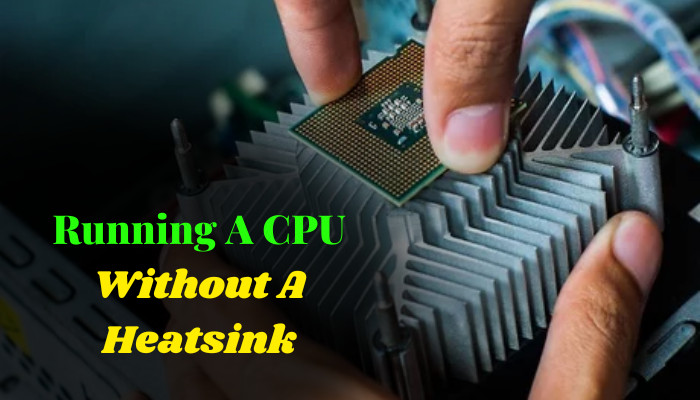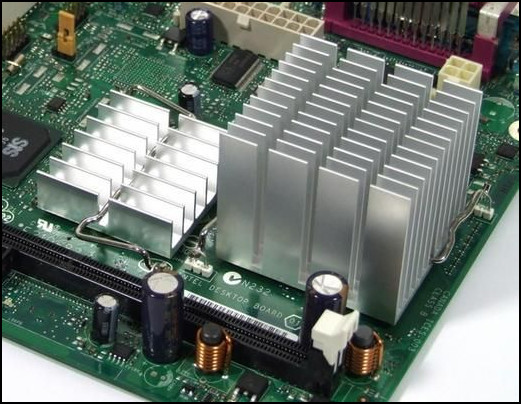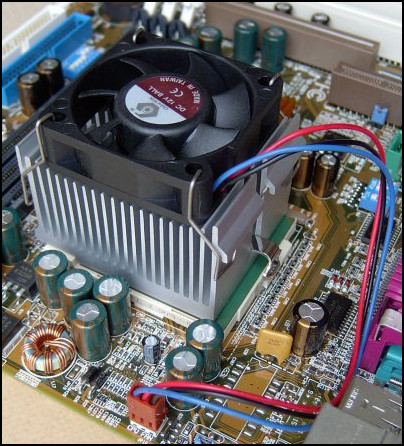If you’re a weird thinker or charm lover, you might think of kicking out your gigantic heatsink from your PC. A “CPU without a heatsink” is not a conventional thought to be executed.
Though I have half-decade experience in testing setups without heatsinks in specific circumstances. I extensively prohibit end users from performing such unsafe trials.

Undoubtedly, I’ll drive you through the possibilities of running a CPU without a heatsink and advise some alternatives.
Is it Safe to Run a CPU without a Heatsink?
A big NO, at first thought. Any hardware geek would say that on any given day. As everyone knows, the harm caused by heat to electronic peripherals is hazardous.
Silicon is the primary material that processors are made of, which is so sensitive to heat that it may melt down your CPU into ice cream. Furthermore, Billions of transistors in the CPU have to pass an enormous amount of digital signal when operating, electricity resistance generates heat accordingly.
So, it’s logically impossible to keep a processor running without a heatsink. The CPU will get extremely hot.
But if you are stubborn and careless enough to continue, then you may face the Thermal Shutdown. And that is executed automatically by modern CPUs to save you from toasting your CPU and damaging allied components.
Finally, you can at least run your PC without a heatsink installed if you have Fail Safe technology, which causes a thermal shutdown at a certain temperature rise. But the test isn’t worth trying on an older setup.
How Long Can You Run the CPU Without Heatsink?
The Fail Safe technology might save your ass from absolute damage, caused by the absence of a heatsink.
It’s fairly tough to predict the exact runtime, or how long you can run your PC. But surely, you can’t run any heavy load program. Your PC will produce enough heat to reach 50-70℃ just to boot into the OS.
Here are the instructions you should follow before checking a CPU without a heatsink:
Safety precautions before running a CPU without a Heatsink
Although your computer will perform a thermal shutdown at a temperature of around 100℃ (212℉), you might feel curious about how long it can run.
Further than that, you may be capable of browsing your own file system & one or two Chrome tabs, but opening a high-res video or any CPU-intensive program will lead your CPU temperature to 100 degrees instantly. Then your PC will shut down automatically. Several attempts at such incidents will permanently damage your CPU, even if your Fail Safe worked successfully.
Several attempts at such incidents will permanently damage your CPU, even if your Fail Safe worked successfully.
Read more on whether can I overclock a RAM without Heatsink.
Why Do We Need Heatsink?
Most processors have multiple cores and threads with lots of transistors in chips. Those transistors require passing numerous bits (1s & 0s) to perform tasks. Since such electricity passing generates lots of heat due to resistance, processors naturally get hot.
To keep the processor working, and suitable performance, it’s inevitable to cool it down. The heatsink retrieves processor-produced heat and spreads it across its surface to release the heat with the help of air.
If you don’t have a heatsink attached to your CPU, it can’t spread heat and will melt itself. But you may have doubts about why smartphone CPUs (SoCs) don’t require a heatsink.
Here is the explanation of how a Smartphone CPU operates without a heatsink:
Why do Smartphone CPUs Not Need a Heatsink?
The architecture of a Smartphone SoC and Computer processor isn’t similar. Smartphone SoCs are ARM-based processors, and Computer CPUs have an x86 build.
Whereas a computer CPU can take a heavy workload and perform multiple tasks simultaneously, a smartphone CPU can’t actually handle much. The most powerful SoC of a smartphone can’t even beat the performance of an average computer CPU.  Plus, Smartphone processors have a lower clock speed. Wait, does that mean a smartphone processor also needs heatsink?
Plus, Smartphone processors have a lower clock speed. Wait, does that mean a smartphone processor also needs heatsink?
The answer is Yes, Although both Smartphone SoCs and Computer CPUs seem to work the same way, Smartphone processors use a distinct technology called Reduction Instruction Set Computing.
This is the reason smartphone processors don’t need a heatsink to remove extra heat. Despite this fact, it also generates a certain amount of heat, which is spread across the chassis.
What Are the Alternatives of CPU Heatsink?
Giant heatsinks indeed look odd in a CPU chassis. Those spoil the elegance, and RAM clearance is an issue that arises often. Or you may have an almost air-tight PC Case, which can’t draw sufficient air in or out.
Here are some alternatives that can fulfill your fetish for a clean interior of a PC:
Radiator & AIO
You can use a radiator with the support of an AIO pump. Which can cool down your CPU leaving the interior clean, Instead of a giant heatsink PC. AIO coolers are an often used component nowadays for increasing aesthetics in PC interiors.
Speaking of aesthetics, check out the list of the top 7 RGB CPU AIO coolers you can buy in 2023.
Liquid Cooling
The liquid cooler is another great alternative to the heatsink that makes your chassis interior look elegant, plus it offers better cooling than the heatsink. You must keep in mind that liquid cooling is an expensive choice.
Here’s a list of the Best 120 mm Liquid CPU coolers available in 2023.
Liquid nitrogen
If you are an extreme user who wants to push the limit and try crazy things, you can also try liquid nitrogen cooling, which is not a regular solution. And it’s horribly costly to even use for a short period.
FAQs
Is it safe to remove the CPU heatsink?
If you know how to dismantle a heatsink from a CPU correctly, you can remove it to clean and reinstall it.
Can you run a CPU without thermal paste?
In the first place, Yes you can run your PC, but it will leave your system significantly alleviated. And the CPU will run hotter than it should.
Can you run a PC without a fan?
As long as you have a heat sink installed upon your CPU, your PC will run and the heatsink will cool down your PC passively. But you can’t use your PC optimally.
Can a CPU cooler damage a motherboard?
If your CPU Cooler didn’t fit your CPU motherboard, or it’s loosened, you might do irreversible damage to your motherboard.
Final Recommendations
Basic requirements are obligatory for any circumstances & use cases like a heatsink of a CPU. Either you have to use one to satisfy the CPUs’ necessity, or you need an equivalent alternative.
Whether you like it or not, the facts are inflexible. Thus, you can not just omit an important component from a computer set and enjoy the desired outcome.
Make sure you let us know if this article helped you decide what you should do and what are the possibilities with alternatives.




